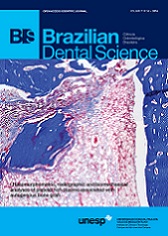A comparative study of the conventional and digital intraoral radiography methods for root canal length measurement
DOI:
https://doi.org/10.14295/bds.2014.v17i4.997Abstract
Objective: Measurement of root canal length is one of the most important stages of endodentic treatment, and any error at this stage can lead to the failure. This study aimed to compare conventional and digital intraoral radiography in measurement of root canal length. Material and Methods: In this study, 35 single-canal maxillary teeth were collected. Access cavities were prepared. An endodontic number 10#K- file was introduced into the canal, until the tip was visible at the apical foramen and the actual canal length (gold standard) was determined. After acquisition conventional radiographs using E-Ektaspeed and F-Insight film (Eastman-Kodak Co. Rochester, NY, USA) and digital radiographs using Photostimulable Phosphor Plates(PSP) (Soredex, Helsinki, Finland) and Charge Coupled Devices (CCD)(RVG, Trophy,NY,USA). they were examined separately with a two-week interval by two oral and maxillofacial radiologists. The data were analyzed with ANOVA and Tukey’s tests using SPSS-19 software (SPSS Inc., Chicago, IL, USA). Result: No statistically significant difference was observed between different radiographies, and different observers (P > 0.05). Nevertheless, in comparison with the gold standard, in all cases, the F-speed conventional radiography and the digital CCD radiography showed the highest and the lowest accuracy, respectively. Also, the PSP and the E-speed conventional radiography were in the second and third order of accuracy, respectively. Conclusion: The use of digital radiography does not improve the accuracy of the root canal length measurement,but the digital technique has advantages,such as the reduced patient exposure ,eliminating the time consuming processing stages, and producing fast images.
Downloads
Downloads
Additional Files
Published
How to Cite
Issue
Section
License
Brazilian Dental Science uses the Creative Commons (CC-BY 4.0) license, thus preserving the integrity of articles in an open access environment. The journal allows the author to retain publishing rights without restrictions.
=================




























